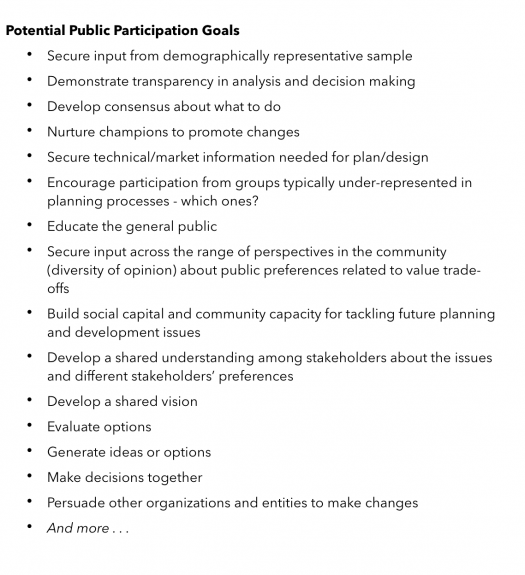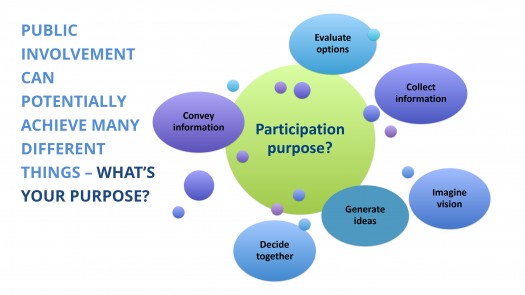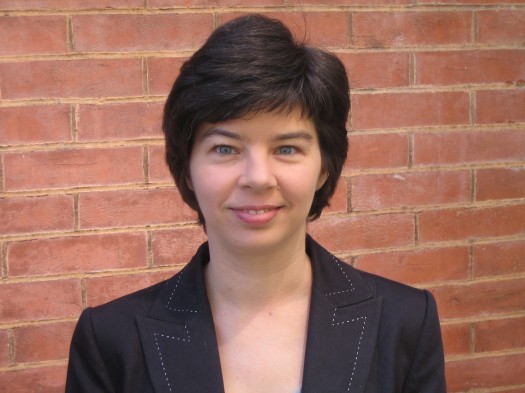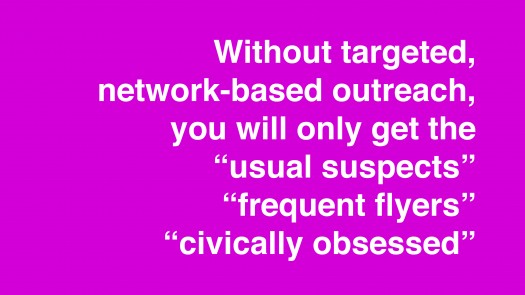A Placemaking Journal
Public Participation, Part I: Let’s Fix What’s Not Working
This is Part I of a two-parter on this topic. The conversation is the third in our series addressing planning challenges in an era likely to be reshaped by the COVID-19 pandemic. The two previous topics can be found here and here.
Jennifer Hurley is President & CEO of Hurley-Franks & Associates, a planning consultancy firm, and a PhD candidate in Human and Organizational Development at Fielding Graduate University. She’s a current or past board member of a number of professional organizations, including The Congress for the New Urbanism, the National Charrette Institute, and the Form-Based Codes Steering Committee.
Ben Brown: Because of your experience and your recent Ph.D work on these topics, Jen, I’ve been looking forward to checking in with you about frustrations I think we share about public participation processes. The pandemic lockdown has severely limited, if not eliminated altogether, in-person meetings. That’s added to the challenges. But before we get into pandemic-specific issues, let’s talk about what’s been going wrong all along. It seems that, increasingly, local governments are hoping for a politics fix in Requests for Proposals for planning projects. They appear anxious to outsource to consulting teams responsibilities to stay in touch with their own citizens.
Jennifer Hurley: Well, let’s look at this from the poor planner’s perspective. Most of them became planners because they wanted to help people and make the world a better place. But they got no training in group collaboration or consensus-building and then were thrown into an increasingly polarized and contentious political environment with fewer and fewer resources and more and more angry people. No wonder some of them just try to keep their heads down and work behind the scenes.
BB: So how is that working out?
JH: That approach often works for the more routine projects, but it can really backfire when members of the public disagree about what to do. The danger here is that many of the problems we face require group collaboration. They require many different people in different organizations and government agencies and businesses to work together, or at least work in the same direction in order to make progress. And the old style of top-down decision-making or present-and-defend “engagement” just doesn’t build the kind of support needed to work together. When government can’t work effectively to achieve what we need, people become more and more distrustful and suspicious. People build trust by being trustworthy, and that means making commitments and delivering on them.
BB: How do we do better?
JH: I’ve been thinking about this a lot. The approach I’m still developing is about coaching clients to better organize their own public participation process as they take on a planning project. I work with the project team to develop a public involvement strategy suited to the particular needs of a specific project, and then I do some hand-holding along the way – helping staff develop the skills to do the work themselves. We start with a big set of potential goals for a public involvement effort, and I go through a prioritization activity with the client project team to rank the goals and then choose just three to four to focus on. Selecting these goals is important because “public involvement” is a very broad category that can include all kinds of different potential goals, and you need different tools to achieve different purposes. And it’s important to focus on just three or four because otherwise you’re just kidding yourself – none of us have the time or resources to do more than three or four.
BB: This sounds like it could be an in-house step, maybe helped along by a coaching consultant, that would lead to a much better focused RFP.
JH: Absolutely. It’s amazing to me how much most clients haven’t thought about this at all and also how different the goal ranking is from project to project. And by the way, so far no one has ever chosen “demographically representative input” as a top priority.


BB: I like that you’ve called out that “demographically representative input” phrase since versions of it are expressed or implied in lots of RFPs. This first-step focusing exercise is missing from lots of projects, because clients tend to assume the wish list in the RFP sufficiently asserts the goals, along with the expectation to engage sub-groups of the population they haven’t successfully brought into community conversations up until now. Once you have those three or four refined goals, what’s next?
JH: The next step is to come up with a way to measure success for each of the goals. When we get to the end of the project, how do we know if we achieved X goal? It usually includes some kind of outcome measure (City Council adopts new zoning code by a certain date). But measures also include more process-y items. (For instance: Project team reviews and participants’ evaluation forms give positive ratings for, “I believe this plan will reflect the range of opinion in the community.”)
BB: Another example of classic strategic planning missing from lots of planning processes.
JH: What’s amazing about this step is that, first of all, their heads kind of explode, because they’ve never thought about trying to measure goals in such specific ways; and, second, usually a couple of the goals fall off the priority list because they realize they don’t care enough about them to measure them.
BB: So now you’ve outlined two drill-down stages before getting to what, in many processes, is on the agenda for the first team meeting with a client: talking about whom to target for participation and how to reach them.
JH: The preliminary organizational stage really helps the team keep focus throughout the project. Without asking and answering these questions, everything has a tendency to default to more – more people to talk to, more meetings, more time to take a project to conclusion.
BB: So if the answer isn’t more, what is it??
JH: Even if we do the best outreach job ever in the history of planning, we’re still only going to get input from a minuscule fraction of the population. So we can’t just rely on big numbers to solve our representation problem. We need to make sure that we are hearing from all of the important stakeholders—and that includes everyone who is directly affected by the project as well as everyone who can influence the decisions about a project. And the only way to do that is to figure out who the missing stakeholders are likely to be for a particular project and do targeted outreach and engagement with those people.
BB: Which gets us to equity issues. We’ll save that for a deeper dive in Part II of this conversation.
A quick reminder that our urbanist colleagues around the world are leveraging their experience and their analyses of the pandemic’s impacts to test new approaches. They’re blogging ideas, as well. Among those we’re following: The Congress for the New Urbanism’s “Public Square”; the Project for Public Spaces; and this virtual lecture by Victor Dover.
–Ben Brown
If PlaceShakers is our soapbox, our Facebook page is where we step down, grab a drink and enjoy a little conversation. Looking for a heads-up on the latest community-building news and perspective from around the web? Click through and “Like” us and we’ll keep you in the loop.








